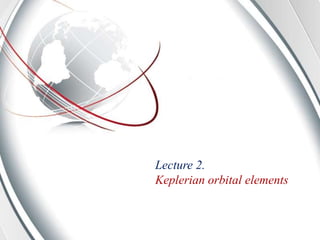
Keplerian orbital elements (lecture 2)
- 1. Lecture 2. Keplerian orbital elements
- 2. GENERAL DEFINITION The elements of an orbit are the parameters needed to specify that orbit uniquely. The problem of satellite motion in space contains three degrees of freedom (the 3 coordinates). Therefore, each particular orbit is fully defined by six quantities - the initial values of satellite’s position and velocity (as 3 derivatives from 3 coordinates). For this reason, all sets of orbital elements contain exactly six parameters.
- 3. Orbital elements specify the satellite’s position at a certain time called the epoch. The elements are only accurate for a limited period around the epoch. EPOCH In astronomy, an epoch is a moment in time used as a reference point for some time- varying astronomical quantity.
- 4. The semi-major axis fixes the size of satellite’s orbit. It is one half of the major axis, and thus runs from the centre through a focus to the edge of the ellipse; essentially, it is the radius of an orbit at the orbit's two most distant points. For the special case of a circle, the semi-major axis is the radius. SEMI-MAJOR AXIS
- 5. ECCENTRICITY The eccentricity (ε) fixes the shape of satellite’s orbit. The eccentricity tells you how flat the orbit is. This parameter indicates the deviation of the orbit from a perfect circle. A circular orbit has an eccentricity of 0, while a highly eccentric orbit is closer to (but always less than) 1.
- 6. INCLINATION The orbit ellipse lies in a plane, and this plane forms an angle with the plane of the equator. This angle is called the orbital inclination. Inclination defines the orientation of the orbital plane.
- 7. LONGITUDE OF THE ASCENDING NODE The satellite orbit cuts the equatorial plane at two points: the first, called the descending node, where the satellite passes from the northern hemisphere to the southern hemisphere, and the second, called the ascending node, where the satellite passes from the southern hemisphere to the northern hemisphere.
- 8. LONGITUDE OF THE ASCENDING NODE The longitude of the ascending node is longitude of a point where the satellite crosses the equatorial plane headed from South to North. Two numbers orient the orbital plane in space. The first number is inclination. The second one is longitude of the ascending node.
- 9. Satellite’s ground track is the path on the surface of the Earth that lies directly below its orbit. The ground track of a satellite can take a number of different forms, depending on the values of the orbital elements, parameters which define the size, shape, and orientation of the satellite's orbit.
- 10. ARGUMENT OF PERIGEE The argument of perigee (ω) is the angle formed between the two directions to the point of perigee and the point of ascending node. So, if the perigee would occur at the ascending node, the argument of perigee would be 0.
- 11. TRUE ANNOMALY The true anomaly (υ) tells you where the satellite is in its orbital path. True anomaly is the angle measured in the direction of motion from perigee to the satellite's position at epoch time.
- 12. TWO-LINE ELEMENT FORMAT The North American Aerospace Defense Command (NORAD) developed the Two-Line Element (TLE) format for transmitting satellite orbital elements. This is a structured format intended to be very compact. TLE set consists of two 69-character lines of data which can be used to determine the position and velocity of the associated satellite. The only valid characters are the numbers 0-9, the capital letters A-Z, the space, and the plus and minus signs—no other characters are valid. 1 NNNNNC NNNNNAAA NNNNN.NNNNNNNN +.NNNNNNNN +NNNNN-N +NNNNN-N N NNNNN 2 NNNNN NNN.NNNN NNN.NNNN NNNNNNN NNN.NNNN NNN.NNNN NN.NNNNNNNNNNNNNN International Space Station 1 25544U 98067A 04236.56031392 .00020137 00000-0 16538-3 0 5135 2 25544 51.6335 341.7760 0007976 126.2523 325.9359 15.70406856328903
- 13. Field Column Description 1.1 01 Line Number of Element Data 1.2 03-07 Satellite Number 1.3 08 Classification 1.4 10-11 International Designator (Last two digits of launch year) 1.5 12-14 International Designator (Launch number of the year) 1.6 15-17 International Designator (Piece of the launch) 1.7 19-20 Epoch Year (Last two digits of year) 1.8 21-32 Epoch (Day of the year and fractional portion of the day) 1.9 34-43 First Time Derivative of the Mean Motion 1.10 45-52 Second Time Derivative of Mean Motion (decimal point assumed) 1.11 54-61 BSTAR drag term (decimal point assumed) 1.12 63 Ephemeris type 1.13 65-68 Element number 1.14 69 Checksum (Modulo 10) Table 1. Two-Line Element Set Format Definition, Line 1
- 14. Field Column Description 2.1 01 Line Number of Element Data 2.2 03-07 Satellite Number 2.3 09-16 Inclination [Degrees] 2.4 18-25 Right Ascension of the Ascending Node [Degrees] 2.5 27-33 Eccentricity (decimal point assumed) 2.6 35-42 Argument of Perigee [Degrees] 2.7 44-51 Mean Anomaly [Degrees] 2.8 53-63 Mean Motion [Revs per day] 2.9 64-68 Revolution number at epoch [Revs] 2.10 69 Checksum (Modulo 10) Table 2. Two-Line Element Set Format Definition, Line 2
